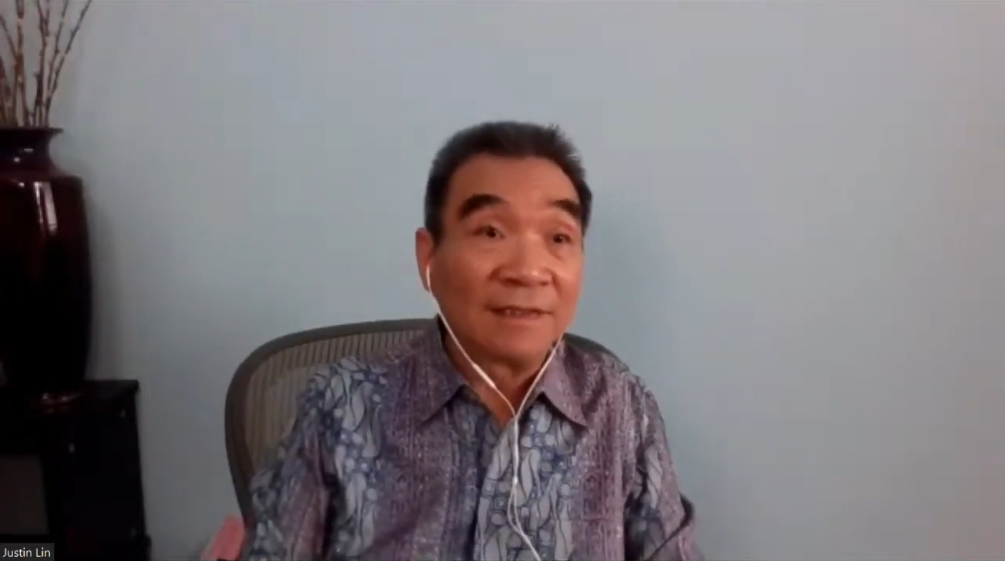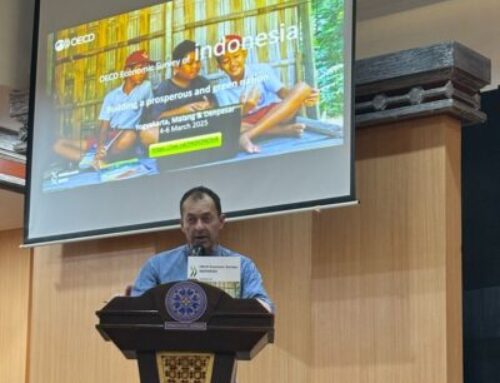Public Lecture hosted by LPEM Universitas Indonesia, FEB Universitas Gadjah Mada, and ANU Indonesia Project in honour of Professor Mohammad Sadli and Professor Mubyarto with Justin Yifu Lin (Peking University), Muhammad Edhie Purnawan (Universitas Gadjah Mada), and Kiki Verico (Universitas Indonesia). Friday, 13 November 2020
KEY POINTS:
- In order to escape the middle income trap, a country needs to grow dynamically for an extended period to achieve convergence to the income level of high income countries. A country must follow its comparative advantage to develop the economy’s industries and infrastructure. Almost all governments in the world attempted to use industrial policies to play the facilitating role, but most of them failed. The reason is that the government’s targeted industries went against the country’s comparative advantages.
- For an industrial policy to be successful, it should target sectors that conform to the economy’s latent comparative advantage. The latent comparative advantage refers to an industry in which the economy has low factor costs of production but the transaction costs are too high to be competitive in domestic and international markets. A resource abundant country, like Indonesia, will be a blessing if it has a good management of resources and uses the wealth generated from the resources to facilitate structural transformation by investing in the improvement of infrastructure and human capital.
SUMMARY
- Indonesia has been trapped in middle income status since the 1960s. Indonesia was able to exceed the average of the middle-income countries average GDP per capita in the late 1990s prior to the Asian Financial Crisis. However, Indonesia was unable to move above the middle income since then. Many countries encounter the same trap, but it is not a destiny since Japan, Korea, and Singapore have been able to move to high income levels. China and Malaysia are likely to become high income countries in 2025.
- In order to escape the middle-income trap, a country needs to grow dynamically for an extended period to achieve convergence to the income level of high income countries. An industrial policy is essential for the government of a middle-income country to prioritise the use of its limited resources to facilitate technological innovation and industrial upgrading. The problem is almost all governments in the world attempted to use industrial policies to play the facilitating role, but most of them failed. The reason is that the government’s targeted industries went against the country’s comparative advantages. In developing countries the targeted sectors are often too capital intensive, an example for that is Indonesia’s aeroplane industry. On the other hand, in developed countries the targeted sectors are often too labor intensive, for example the agricultural sector in land-scarce high income countries such as Japan. The firms in those targeted sectors were non-viable in the competitive market, but the government kept supporting them through subsidies and protections. Those measures led to misallocation of resources and rent-seeking.
- In a new structural economics, the core idea is that a country’s economic structure is endogenous to its factor endowments (the amount of capital, labor, and natural resources). In order to achieve competitive advantage, a country needs to develop its industries according to its comparative advantages determined by factor endowments. A country must follow its comparative advantage to develop the economy’s industries and infrastructure to achieve dynamic growth and convergence. If a country is consistent with its comparative advantage, the country will be competitive in both domestic and international markets and generate the largest possible surplus. The returns to investment will be maximized and the propensity to save will be at its highest. Capital will be accumulated in the fastest way possible. The changes in endowment structure and comparative advantages pave the way for changes in industrial structure and the accompanying hard and soft infrastructure.
- For an industrial policy to be successful, it should target sectors that conform to the economy’s latent comparative advantage. The latent comparative advantage refers to an industry in which the economy has low factor costs of production but the transaction costs are too high to be competitive in domestic and international markets. Once the government helps the firms to reduce risks and transaction costs, firms will be viable and the sectors will be competitive.
- Historical evidence shows that successful countries in their catching up stage all targeted industries in dynamically growing countries with a similar endowment structure and moderately higher per capita income. Unsuccessful industrial policies on the other hand targeted industries in countries where the per capita GDPs were less than 20% of the targeted countries. For countries with a similar endowment structure, the forerunners’ successful industrial development provides a blueprint for the latecomers’ industrial policies.
- How can the government pick the sectors that are in line with the economy’s latent comparative advantages?
- Find fast growing countries with similar endowment structures and with about 100% higher per capita income, then identify the dynamically growing and tradable industries that have performed well in those countries. See if there are some private domestic firms that are already in those industries and identify their constraints.
- In industries where no domestic firms are present, seek FDI from countries identified before, or organize new firm incubation programs.
- In addition to the first industry identification, the government should also pay attention to spontaneous self discovery by private enterprises and give support to scale up successful innovations in new industries.
- In countries with poor infrastructure, special economic zones may be used to overcome barriers to entry, attract foreign direct environment (FDI), and encourage industrial clusters. Government may compensate the identified pioneer firms with tax incentives for limited periods, direct credits for investments, and foreign exchange access.
- A resource abundant country, like Indonesia, will be a blessing if it has a good management of resources and uses the wealth generated from the resources to facilitate structural transformation by investing in the improvement of infrastructure and human capital. The government should be proactive for this to happen. If the Indonesian government uses an effective industrial upgrading according to its comparative advantages, it should be able to maintain 7% or more growth rate annually for 20 years or more. with 7% or more growth rate, Indonesia will cross the threshold of $12,535 and become a high-income country within 20 years.
- There are some important notes for the case of Indonesia. Indonesia took 50 years to move from middle income to the upper middle-income level. To reach a high-income level in 20 years will be very challenging, for the time is very limited. Many countries stay in the upper middle income without reaching high income status. Japan, Singapore, and Korea graduated from upper middle income with double digit growth and a stable exchange rate. Based on his calculations, Kiki Verico estimated that Indonesia needs at least 6.6% growth until 2040 to be a high income country, which is not an easy feat especially given the COVID-19 pandemic.
- There are some criticisms and challenges about the new structural economics approach for Indonesia, including:
- To avoid the middle-income trap before the 2040s, is the manufacturing sector the most essential source of economic growth in Indonesia? How do we mitigate the temporary impacts of economic transformation on income gap, open unemployment, poverty, and urbanization?
- From the latest update of Indonesia’s economic growth, agroindustry is the most resilient and high growing sector in the economy. Should we stay focused on labor intensive manufacturing, or should we move to the agroindustry? Or avoid picking winners and let the market decide?
- And related to the earlier point above, how can we avoid the rent seeking behavior that often comes with picking winners?





